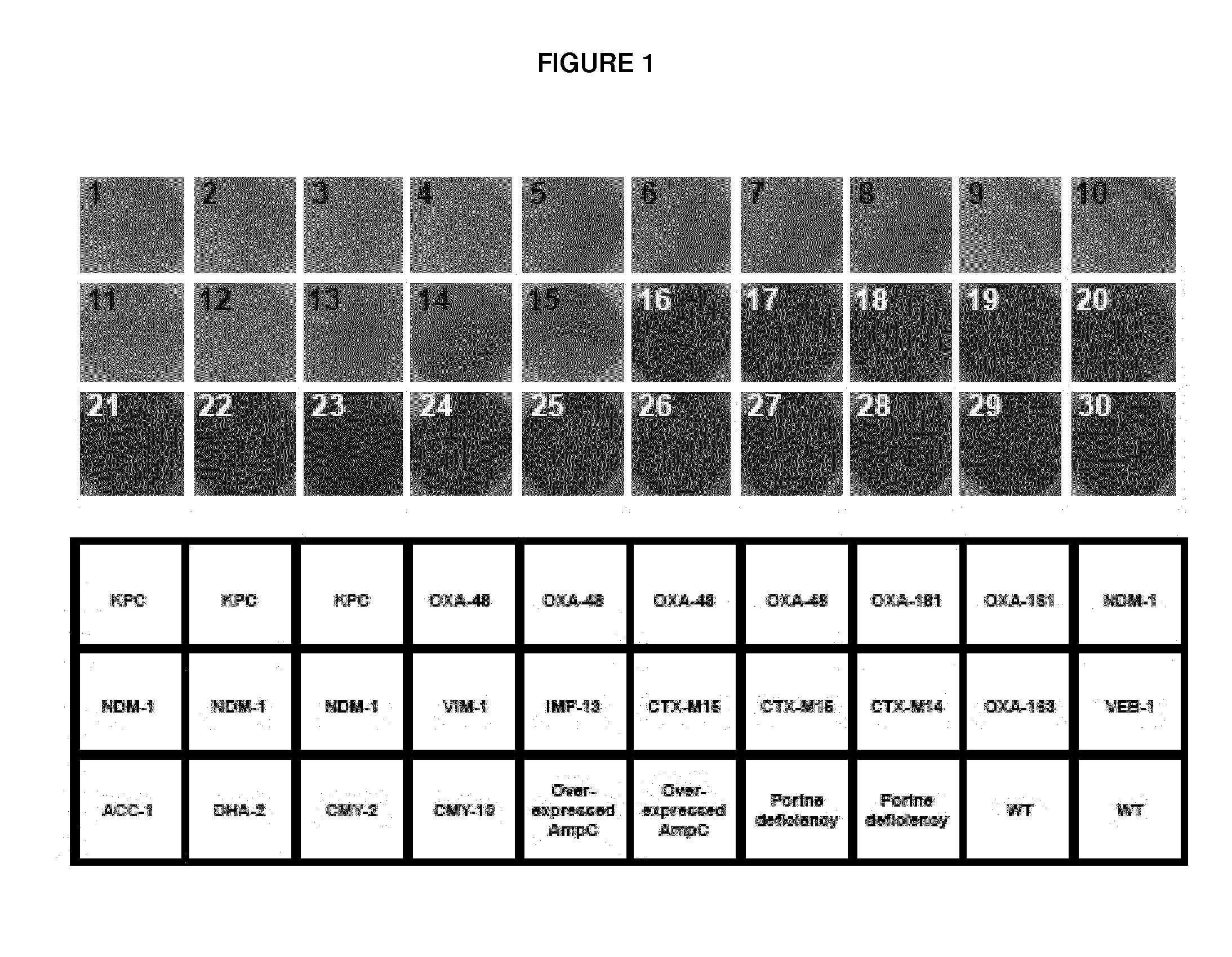Method for detecting the presence of carbapenemase-producing bacteria in a sample
a technology of carbapenemase and bacteria, which is applied in the field of methods for detecting the presence of carbapenemase-producing bacteria in samples, can solve the problems of high cost, time-consuming, and insufficient specificity of phenotypic-based techniques, and achieves the effects of reducing the number of samples, and improving the quality of the sampl
- Summary
- Abstract
- Description
- Claims
- Application Information
AI Technical Summary
Benefits of technology
Problems solved by technology
Method used
Image
Examples
example 1
Method (Acido-Colorimetric Test) According to the Invention
[0095]Thirty six carbapenemase-producing isolates of various enterobacterial species of the Applicant's own strain collection and of worldwide origin were included in the study (Table 1). These strains had been previously characterized for their beta-lactamases content at the molecular level.
[0096]The collection of strains also contained a series of isolates with decreased susceptibility to carbapenems by non-carbapenemase based mechanisms or by producing non-carbapenemase broad spectrum beta-lactamases frequently identified among clinical isolates (Table 2).
[0097]Prior to performing the method of the invention, susceptibility testings were performed by determining Minimum Inhibitory Concentration (MIC) values by the Etest® (AB bioMérieux; Solna, Sweden) on Mueller-Hinton agar plates at 37° C. and results of susceptibility testing were recorded according to the Clinical and Laboratory Standards Institute (CLSI) guidelines as...
example 2
Rapid Detection of Carbapenemase-Producing Enterobacteriaceae
[0102]Abstract
[0103]The Carba NP test was developed for a rapid identification of any carbapenemase producer in Enterobacteriaceae. This biochemical test using isolated bacterial colonies is based on in-vitro hydrolysis of a carbapenem, imipenem. It was 100% sensitive and specific as compared to molecular-based techniques. This rapid (less than 2 h) and inexpensive technique may be implemented in any laboratory. It constitutes a real change of the paradigm for controlling the spread of carbapenemase producers worldwide.
[0104]Study
[0105]One hundred sixty-two carbapenemase-producing strains of various enterobacterial species isolated from various clinical samples (blood cultures, urine, sputum, . . . ) from our own strain collection and of global origin, were included in the study (Table 3). This collection of strains also included forty-six strains being fully susceptible to carbapenems or showing a decreased susceptibility...
example 3
Rapid Detection of Carbapenemase-Producing Pseudomonas spp.
[0112]Abstract
[0113]Carbapenem resistance in Pseudomonas spp. is mainly related to decreased outer-membrane permeability, or to expression of carbapenemases. Currently, carbapenemases detection relies on phenotypic- or molecular-based techniques that are either not enough sensitive or specific, or are expensive. In addition, those techniques are time-consuming and therefore of limited clinical interest. A novel technique, the Carba NP test, based on the in-vitro hydrolysis of a carbapenem, has been here evaluated to detect carbapenemase production in Pseudomonas spp. It was tested with 36 carbapenemase and 72 non-carbapenemase producers. The Carba NP test was specific and sensitive (100% and 94.4%, respectively), and rapid (less than 2 h). This cost-effective technique can be implemented in any clinical microbiology laboratory worldwide. It offers a reliable technique for identification of carbapenemase-producing Pseudomonas...
PUM
| Property | Measurement | Unit |
|---|---|---|
| temperature | aaaaa | aaaaa |
| temperature | aaaaa | aaaaa |
| temperature | aaaaa | aaaaa |
Abstract
Description
Claims
Application Information
 Login to View More
Login to View More - R&D
- Intellectual Property
- Life Sciences
- Materials
- Tech Scout
- Unparalleled Data Quality
- Higher Quality Content
- 60% Fewer Hallucinations
Browse by: Latest US Patents, China's latest patents, Technical Efficacy Thesaurus, Application Domain, Technology Topic, Popular Technical Reports.
© 2025 PatSnap. All rights reserved.Legal|Privacy policy|Modern Slavery Act Transparency Statement|Sitemap|About US| Contact US: help@patsnap.com

